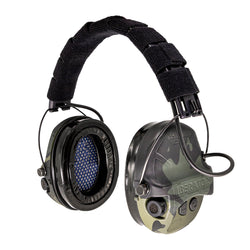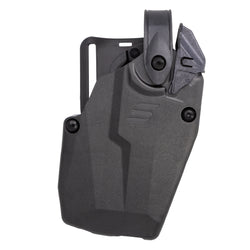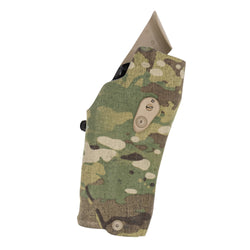C&H Precision is a well-known industry leader in high-quality pistol optic adapter plates. That focus naturally led to the company’s own line of pistol optics. Two of their most popular models are the Duty-XL enclosed emitter red dot, and the open-emitter EDC red dot. I recently got my hands on these optics, though they came to me in a roundabout way.

My Walther PPQ and PPS are two of my favorite handguns. The PPQ was my first modern semi-auto pistol, and the PPS my first subcompact model. But the surge of optic-compatible pistols left these two a little dated since they don’t have an optic cut. I didn’t mind at first, but my eyes are getting worse with age, causing me to finally give in and start mounting optics on my pistols where possible.
Loving these handguns like I do, I thought perhaps that someone offered aftermarket slide milling, or even slides that were already cut. My first online search took me to the actual Walther website, where they touted their partnership with C&H Precision to specifically cut PPQ and PPS slides. Well, with Walther’s endorsement, why would I go anywhere else?

It also helped that one of my oldest friends, GW Ayers, works at C&H Precision, so I called him and asked about the service. G-Dub convinced me that not only should I send my slides to C&H, I should also equip them with a couple of the company’s red dots. How could I refuse? Fast-forward a few weeks, and my newly-milled slides came back with C&H Precision optics already mounted. Things were looking up.
Check out the video to watch my PPQ slide go through the process.
Let’s look at these C&H Precision red dots that have brought my Walthers back to relevance in my self-defense system. We’ll start with the closed-emitter Duty-XL that adorns my PPQ.
C&H Precision Duty-XL Closed Emitter Red Dot
Closed-emitter red dots are becoming more popular as shooters recognize the extra reliability they provide. Impervious to dust, debris, or water, a quality closed emitter optic is ideal for any environment. And the Duty-XL seems like a quality optic.
The housing is machined from a single block of aircraft-grade aluminum and attached with C&H Precision’s double-bar mount. The optic is sealed and IPX7 waterproof rated, meaning it can withstand being submerged in up to 1 meter of water for 30 minutes.

The controls are easily manipulated, with large, tactile buttons on the left side to cycle through the 10 brightness settings, two of which are night vision-compatible. The windage and elevation dials feature audible and tactile clicks, though you’ll need the included small screwdriver or similar tool to operate them.
The side-mounted compartment for the included CR-2032 battery means you don’t have to remove the optic to change it. It has a slot for a screwdriver or coin, but I’m able to remove the cap with my fingers.
The glass is very clear, and I love the multi-reticle that gives me the option of a single 3 MOA dot, a 30 MOA circle, or the dot within the circle. I prefer the latter. Mine is red, but C&H has a green reticle on the way.
The Duty-XL also features user-enabled motion activation with an automatic shut-off after 225 seconds of inactivity. I like the short cut-off time. There’s no reason for that to take hours, like with some optics. 50,000 hours of runtime is great, but there’s just no need to waste battery life like that.

The Duty-XL requires an adapter plate that is compatible with the double-bar clamp, but C&H has those for you. This optic has the Aimpoint ACRO footprint.
C&H Precision EDC Open-Emitter Red Dot
My subcompact PPS needs a smaller optic, so I went with the RMSc-footprint, open emitter EDC red dot. C&H milled my slide for a direct mount, which is very nice. Like its bigger brother, the EDC is machined from a block of aircraft-grade aluminum, is IPX7 waterproof, and 100 percent shockproof. Both optics are rated to stand up to +P and +P+ ammo.

A smaller surface area means smaller controls, but they function very well, with tactile buttons for the 10 brightness settings and responsive windage and elevation dials. The first two brightness settings are night vision compatible, and the included screwdriver operates the dials and the side-mounted tray for the CR1632 battery.
The multi-reticle is available for the EDC, but mine has the single 3-MOA red dot. The glass is very clear, and the window is larger than many similar-sized optics.
The EDC has the same user-enabled motion activation feature as the Duty-XL, with shut-off occurring after 225 seconds of inactivity to save the 50,000-hour battery life. I timed both optics for myself.
The EDC is also available in the GLX-RMSc footprint for the Glock 43.
Running the Duty-XL and EDC Optics
Both the Duty-XL and EDC have been a pleasure to operate. I wondered how I would like the Duty-XL because I’d never run the bulkier closed-emitter design on a handgun for any real length of time.
I needn’t have worried. The Duty-XL looks bulky, but it doesn’t feel bulky. It adds 2.5 ounces to my PPQ’s weight, but, honestly, I can’t really feel it. And I was very pleased to find that I already had a compatible holster in my Safariland Model 537 GLS.

The EDC only weighs 0.6 ounces, so it may well be a near-wash with the metal removed while milling the slide. I can’t tell any weight difference. This low-profile optic really is perfect for the slim PPS.
Both optics feature rear notches for co-witnessed iron sights, and C&H installed their taller iron sights on my PPQ to make sure I could actually use that rear notch. Thanks to the direct mount, my factory PPS sight is just tall enough, so it didn’t need replacement.
I can say that these C&H Precision red dots are rock-solid. Since I needed the practice anyway, I ran over 500 rounds of 9mm through these two guns over a couple of range trips. They held zero perfectly. My friends at Ammo-to-Go generously provided the 115-grain Federal American Eagle rounds, and I thank them for their continued support.

I acquired the reticles quickly, and after years of denial, I’ll say that I shoot better and more consistently with these optics than without them. They were a real pleasure to use and functioned perfectly.
Built-In Toughness
I’m not one to deliberately knock my equipment around, but I felt like these optics could handle a little abuse, and I knew the Walthers (unloaded with no magazine) could.
So, I bit my lip and dropped each one from chest height onto the gravel flooring of my pistol range. Three times each. Right onto the optics. My faith was rewarded as each optic not only held zero but came away without even a scratch on the finish.
After all my tests, there is no wobble, and each optic feels just the same as when I first unpacked it.
C&H Precision Offers a Great Experience
As I said before, I didn’t know C&H Precision offered the Walther slide-milling service until I actively searched for it. Finding my answer on the actual Walther website surprised me. I hadn’t really expected to find much for these two older guns, even though Walther still produces the PPS.
Knowing G-Dub made it easy for me, but the C&H Precision website makes it just as easy for everyone else. They offer slide milling for the Walther PPQ, PPS, Q4, and Q5 pistol slides. They can also upgrade the PDP 1.0 optic cut to the 2.0 version. You select the options you want. It really is a great service, and I can tell you that the workmanship is top-notch. You’d think my slides came that way from the factory.

Final Thoughts
I had never heard of C&H Precision until my friend started working there a few months ago. I figured I would try a few of their products at some point, but wasn’t aware of the Walther connection until I searched for a milled PPQ slide.
The workmanship on my slides impressed me, as did the optics themselves. The quality and performance are there, and the price is more attractive than I would have thought. The Duty-XL and EDC optics will obviously stay on my PPQ and PPS, respectively, but I expect that I’ll be running C&H optics on some of my other guns before long. Head over to their website and check them out. I bet you’ll like them too.









